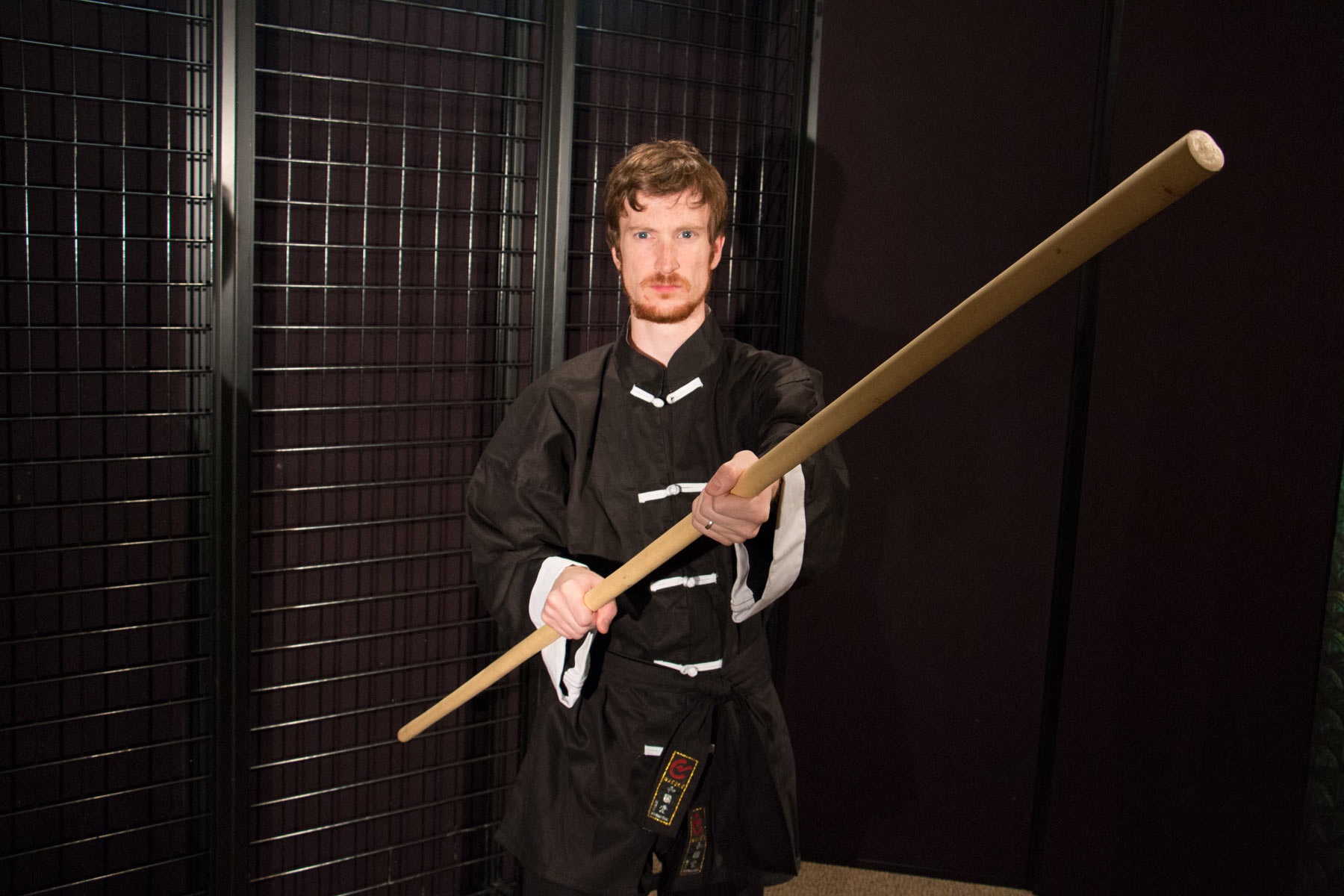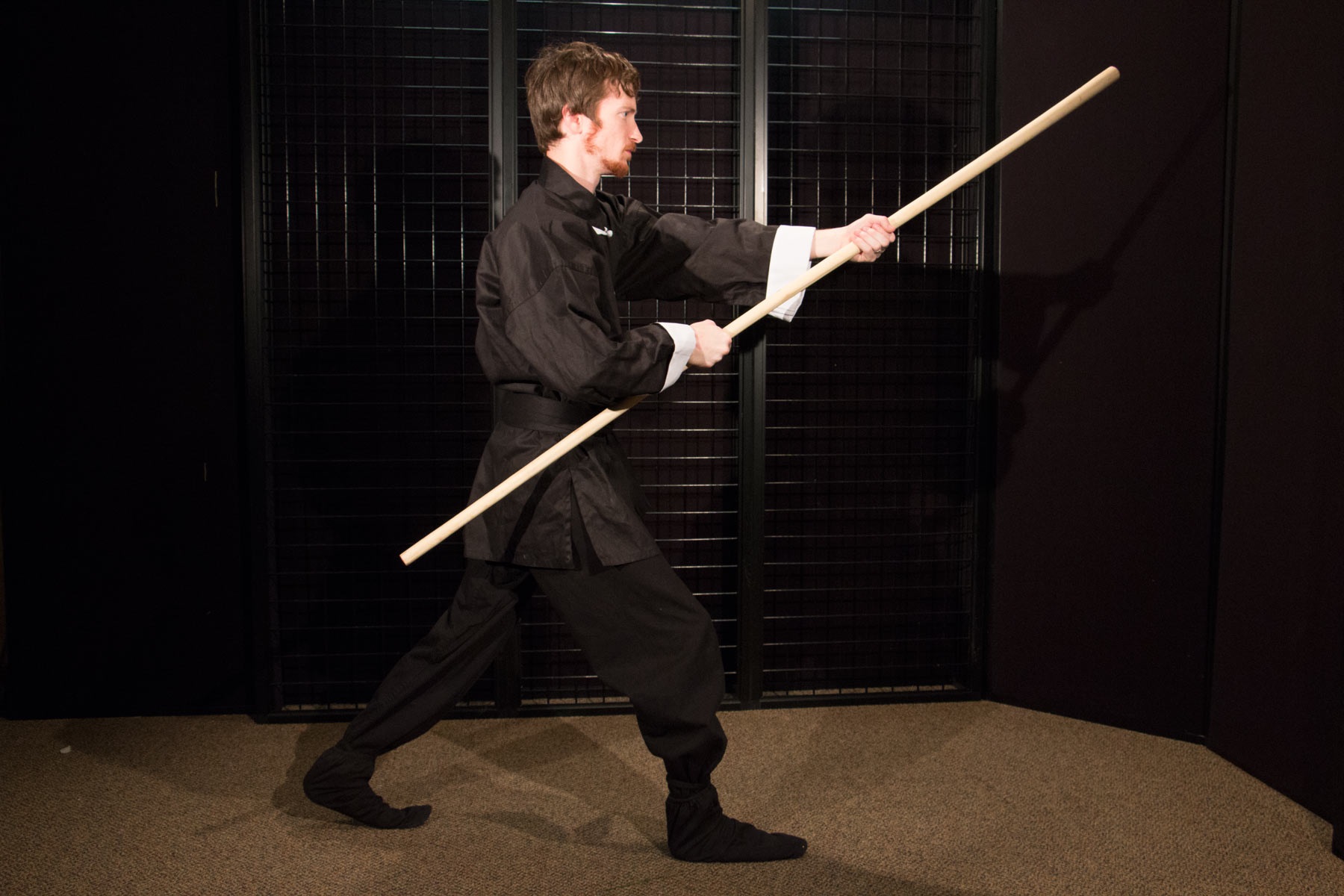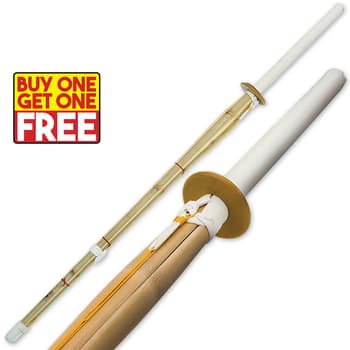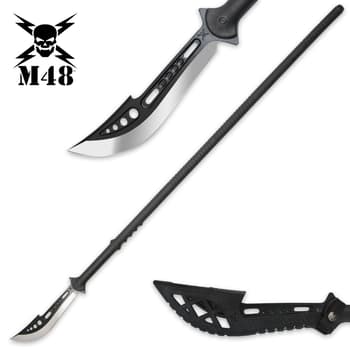Date Published: 2015-11-01
Tips for Bo Staff Training
By Adelia Ladson
 Make sure you have a secure hold; one palm up, one palm down.
Make sure you have a secure hold; one palm up, one palm down.  Make sure you have a secure hold; one palm up, one palm down.
Make sure you have a secure hold; one palm up, one palm down.
 Make sure your stances are solid so that you have a good foundation to strike from.
Make sure your stances are solid so that you have a good foundation to strike from.  Make sure your stances are solid so that you have a good foundation to strike from.
Make sure your stances are solid so that you have a good foundation to strike from.
 Your back needs to be ram-rod straight for Horse Stance.
Your back needs to be ram-rod straight for Horse Stance.  Your back needs to be ram-rod straight for Horse Stance.
Your back needs to be ram-rod straight for Horse Stance.
Shop All Weaponry Here
Training with a weapon is an important part of growing as a martial artist. In most schools, the first weapon you will start training with is the bo staff, which is basically a cylindrical piece of wood that is anywhere between four feet (for younger students) and six feet long. Really, a bo can be made out of any wood or synthetic materials but I believe the wax wood version is better for beginners since they are inexpensive. The staff just needs to be smooth so that it slides comfortably through your hands as you’re maneuvering it.
Since this is, essentially, a doorway weapon to other weapons’ training, you need to really master it. With a bo, you are learning the basics of what the other weapons’ skills are based on. You are learning to make the bo an extension of your body, being conscious at all times where it is in relation to you and the space around you. This is extremely important in all weapons training. Learning to be comfortable and natural with a large weapon like a bo staff, leads to being comfortable with each weapon you progress to. Learning the correct stances and grips and perfecting them will translate to success in future training with more advanced weapons. It is always about getting the basics down and solidified.
Since this is, essentially, a doorway weapon to other weapons’ training, you need to really master it. With a bo, you are learning the basics of what the other weapons’ skills are based on. You are learning to make the bo an extension of your body, being conscious at all times where it is in relation to you and the space around you. This is extremely important in all weapons training. Learning to be comfortable and natural with a large weapon like a bo staff, leads to being comfortable with each weapon you progress to. Learning the correct stances and grips and perfecting them will translate to success in future training with more advanced weapons. It is always about getting the basics down and solidified.
 Make sure you have a secure hold; one palm up, one palm down.
Make sure you have a secure hold; one palm up, one palm down. Make sure you have a secure hold; one palm up, one palm down.
Make sure you have a secure hold; one palm up, one palm down. So, let’s start with your grip on the bo. The importance of having a secure and comfortable grip on the weapon is a no-brainer. To start out, your basic hold is with your hands dividing the bo into thirds. In otherwords, place one hand about a third of the way down from one end and the other hand about a third of the way down from the other end. Your right palm should be face up and your left palm should be face down when you hold the staff in your hands. Unless … you’re left-handed like me and then, I’m sorry but you could be an instructor’s nightmare. If this is the case, and you are left-hand dominant, then switch so that your left hand is face up and show that instructor you will triumph in spite of what he thinks. Whichever hand is palm up will be the hand that leads you in your strikes. Also, don’t hold the bo so tight that you’re white-knuckling it. Just relax and hold it securely.
Once you have your grip, make sure that you do not let your hands twist out of the position that they are in. One palm up and one palm down is the way they should stay. It’s easy, sometimes, to lose track of what your hands are doing when you are concentrating on your stance or performing a strike or block. Now, regardless of what grip you are using, whether the normal, narrow or wide, the above holds true. Keep it secure and relaxed and one palm up and one palm down. You want flexibility of movement but no “dropping it” incidents. That really does drive the instructor crazy.
Once you have your grip, make sure that you do not let your hands twist out of the position that they are in. One palm up and one palm down is the way they should stay. It’s easy, sometimes, to lose track of what your hands are doing when you are concentrating on your stance or performing a strike or block. Now, regardless of what grip you are using, whether the normal, narrow or wide, the above holds true. Keep it secure and relaxed and one palm up and one palm down. You want flexibility of movement but no “dropping it” incidents. That really does drive the instructor crazy.
 Make sure your stances are solid so that you have a good foundation to strike from.
Make sure your stances are solid so that you have a good foundation to strike from. Make sure your stances are solid so that you have a good foundation to strike from.
Make sure your stances are solid so that you have a good foundation to strike from. If you don’t have a sturdy foundation when you train, it doesn’t matter how good your arm and hand movements are. You must perfect your stances. When you do a front stance, make sure your weight is evenly distributed. There is a tendency, sometimes, especially in beginners, to lift that back heel off the floor. All toes should be pointing forward because it’s a front stance. Your torso needs to be perfectly squared-up with your feet. This is your foundation. This is your base you move from. It needs to be stable. Don’t discount it just because it’s the first thing you learned in your karate class. If you aren’t doing it properly, how do you expect to do a cat stance, where most of your weight is on your back leg or how do you expect to strike and block effectively.
 Your back needs to be ram-rod straight for Horse Stance.
Your back needs to be ram-rod straight for Horse Stance. Your back needs to be ram-rod straight for Horse Stance.
Your back needs to be ram-rod straight for Horse Stance. The thing about the horse stance is that people don’t just “sit down” in to it. They tend to stick their butt out and lean forward. Remember, tuck it in and keep your back ram-rod straight. Once you lean forward, there goes your stable foundation to work from. You need to practice (yes I said practice) your basic stances. They seem basic because you learn them early on but you need to make sure they are just about perfect. Use a full-length mirror to make sure your feet are correctly positioned and your body is square. Critique yourself for the front view and the side view. I’ve seen some pretty ugly stances in higher ranked belts due to sheer laziness.
One final, very important tip is: Remember to breathe. I’m really not kidding. Some have the tendency to hold their breath when they execute a movement. It’s very common and they don’t even realize that they’re doing it. So. You need to actually think about breathing as you’re doing your exercises. If you breathe freely, you will move freely. Oh, and while you’re doing that, don’t forget to also concentrate on what your hands, your feet and the bo staff is doing. It all works together and just takes a consistent focus and continued practice. But it needs to be productive practice; not lazy practice. You know the difference.
One final, very important tip is: Remember to breathe. I’m really not kidding. Some have the tendency to hold their breath when they execute a movement. It’s very common and they don’t even realize that they’re doing it. So. You need to actually think about breathing as you’re doing your exercises. If you breathe freely, you will move freely. Oh, and while you’re doing that, don’t forget to also concentrate on what your hands, your feet and the bo staff is doing. It all works together and just takes a consistent focus and continued practice. But it needs to be productive practice; not lazy practice. You know the difference.
Related Products

























